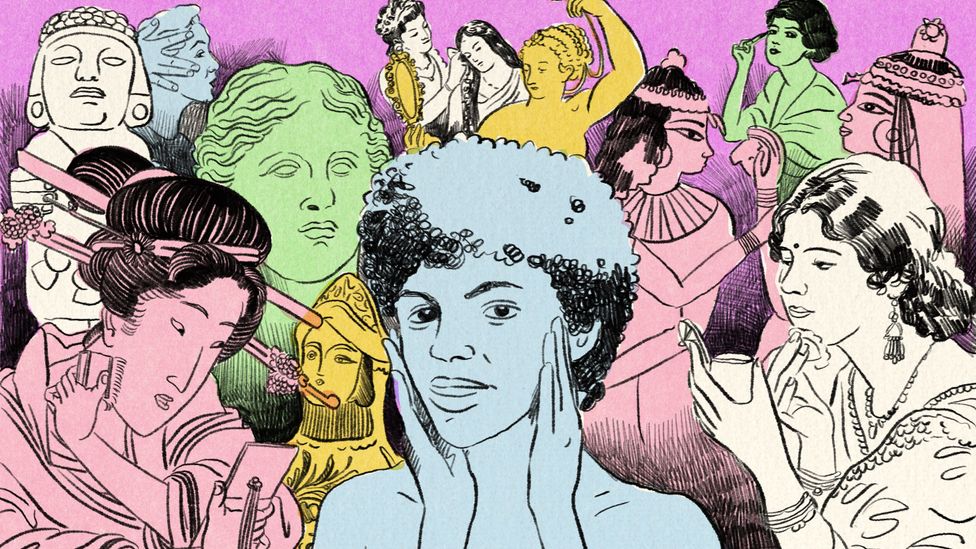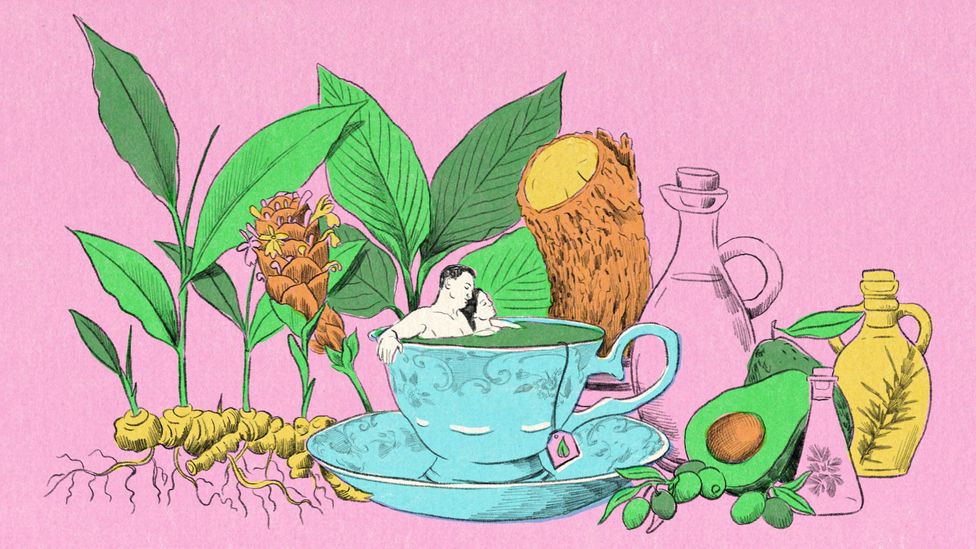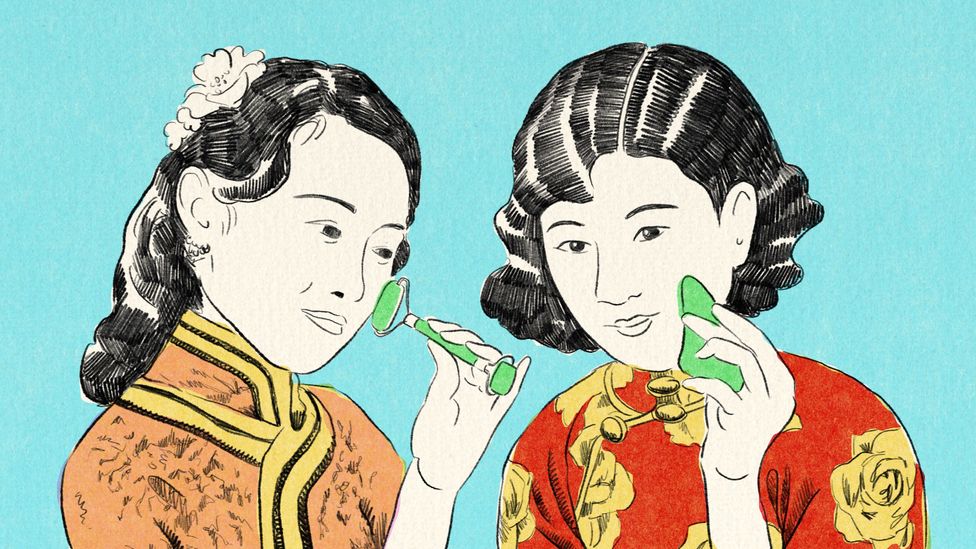The revival of ancient beauty rituals

In the 1963 film Cleopatra, Elizabeth Taylor’s Egyptian queen rejects an invitation from Marc Anthony’s envoy, while sitting naked in a milky flower-filled bath, idly toying with a golden boat. The film may have had its issues – famously, the spats between Taylor and her co-star lover Richard Burton – but the iconography is familiar: in ancient Egypt, queens and goddesses were renowned for their power and sensuality, for their deep associations with the natural world, and with motherhood and healing. Taylor’s Cleopatra is frequently shown bathing and being pampered, as she would have been in real life: the beauty rituals of wealthy ancient Egyptians were lengthy and complicated, beginning with long milk baths infused with saffron oil.
More like this:
– Inside the ethical beauty boom
– The ancient enigma that resonates now
– How to make your clothes last longer
Neither element was accidental: the lactic acid in milk would have helped exfoliate the skin, while saffron has been used to treat a variety of conditions for thousands of years. The spice is carefully harvested from the orange stigmas of the purple Crocus sativus flower. Grown in the hot dry belt of land that runs from Spain in the west to Kashmir in the east, the spice is known as “red gold” for the intensity and price of its production. Flowers must be picked at dawn by hand, and those thin threads delicately scraped. It takes almost 5,000 flowers to yield just one ounce of saffron threads. Prices are already high and, as climate change threatens farming, they’re set to go higher.

(Credit: Emmanuel Lafont)
Set against the futuristic appeal of some of today’s top-selling products, the earthy reality of saffron’s origins may sound irrelevant. Who cares where things come from, as we scoop a soft whip of the latest £80 mega cream from its pot? Quite a few of us, it appears. A 2021 report by the NPD Group found that 68% of consumers want skin care formulated with “clean” ingredients (broadly, without PFAs, parabens and phthalates). Answering calls for greater accountability in the industry, a group of beauty mega brands have launched the EcoBeautyScore Consortium, set to establish a global transparency environmental impact scoring system.
In a similar vein, the new B Beauty Coalition aims to bring together individual certifications to tackle the industry’s substantial impact. Meanwhile, interest in natural and organic ingredients continues to rise – to $11.9 billion in 2020, up 2.9% from the previous year, according to UK-based research firm Ecovia Intelligence. And in this brave new world, with its focus on natural and social equity, traditional ingredients and rituals worthy of Cleopatra are proving rich sources of inspiration. “We have been taught to dismiss tradition and seek out the ‘straight-out-of-the-lab’,” wrote natural beauty guru Imelda Burke, in her 2016 book The Nature of Beauty. “But, while new developments are important, there is so much we can learn from our forebears.”
Take rose oil, for example, with its long history in the Middle East. Still one of the world’s largest producers, Turkey’s love of purified rose water dates back 2,000 years. Today, the oil can now be found in modern incarnations which sell for a hefty sum. And no wonder: packed with vitamins, minerals and antioxidants that moisturise the skin, nature’s most blousy flower is an anti-inflammatory, and can be used for calming irritated skin, while smelling like a National Trust garden.
And, while the Western world has seen the desire for turmeric rise in recent years, not least in lattes, this bright yellow root has been at the core of Ayurvedic practice for more than 4,500 years. “Turmeric is a good immune booster, displaying powerful antioxidant properties some five to eight times more potent than vitamins C and E,” Shabir Daya, in-house pharmacist at Victoria Health, told Vogue. In India, brides and grooms apply turmeric to their hands and faces before the wedding, as a symbol of purification, and as a blessing. Turmeric’s active ingredient is curcumin, though it can have side effects.

(Credit: Emmanuel Lafont)
Meanwhile, Berber women in Morocco are still harvesting argan oil from the thorny branches of its trees. Rich in skin-loving omegas three and six, argan oil has been traded as a coveted beauty agent in and around the Mediterranean for thousands of years. Across the oceans in Polynesia, monoi oil, created by soaking the petals of Tahitian gardenias in coconut oil, dates back 2,000 years to the indigenous Maohi people, who revered it as a skin and hair softener. In Costa Rica, the Bribri and Cabécares people use green tea to improve the complexion, help heal blemishes and reduce inflammation.
All these ingredients have made their way into Western skincare. But the story is no longer about Western brands co-opting exotic herbs and spices as the next “big thing” in some dreadful echo of colonisation. Beauty is seeing a growing number of black and indigenous women taking ownership of their heritages through the revival of ancestral rituals and ingredients in ways that celebrate, rather than appropriate, their cultures – and that work according to their needs. Labels such as Cheekbone Beauty by Anishinaabe-Canadian Jennifer Harper and Prados Beauty, created by Xicana-Arizonian Cece Meadows, build their products around natural herbs, like sage and lavender, which have been utilised by their communities for decades. Many of the founders use their brands to create jobs for their communities, from gathering ingredients in nature to selling the products at farmers’ markets and storefronts.
This vital social understanding is symptomatic of other shifts happening in the industry. “The discussion is changing – from natural and organic to sustainability,” said Armarjit Sahota, president and founder of Ecovia Intelligence, speaking in December 2021 to Cosmetics Design Europe. “We’re seeing more and more sustainable ingredients… A lot of pioneers in natural and organic beauty wanted to develop products that were better for human health and for the environment. Initially, the formulations were plant-based, for lower impact on human health. But, as sustainability has become an important part of the industry, these pioneers have really been leading the charge in terms of sustainability initiatives. It’s no longer just about natural and organic; it’s about wider green issues.”

(Credit: Emmanuel Lafont)
These concerns have not arisen in isolation. “In light of Covid-19 and the accelerating climate crisis causing flooding, drought, crop failure and displacement of people around the world, we are recognising that nature is pushing back,” says Kathryn Bishop, of the strategic foresight consultancy, The Future Laboratory. “It’s time for humans to recognise that we must exist in symbiosis with it, and with respect to it.”
Always linked, the beauty-grooming-environment nexus is finally taking precedence. Consumers are looking for products that reflect and respond to their concerns: for beauty for other people and for the planet and all its life, and they’re looking for practices that calm them – and connect them to a greater whole.
Restoring balance
Ancient customs that drew inspiration from nature and natural ingredients are being unearthed and explored as a means of restoring balance and re-connecting with what matters in the world. Australian wellbeing brand Subtle Energies blends the traditional techniques of the Indian practice of Ayurveda with the benefits of aromatherapy. Its skincare contains essential oils of Palmarosa, Mogra and Frankincense, in base oils of jojoba and ashwagandha. “Essential oils are wonderful tools given to us by mother nature,” says Farida Irani, founder of the brand. “They are the life force, and by using them on ourselves, we are enhancing our own life force. This is ancient wisdom in modern times, helping people to live more consciously, for themselves and for the planet.”
“Ancient practices and approaches to looking after the body, mind, skin and hair have been drawn from the Earth and nature,” Bishop tells BBC Culture. “They are often aligned with particular seasons and seasonal events, celebrating the Earth and the flora and fauna that it kindly provides, respectfully using them in adornment or cleansing or as food and drink. These practices pre-dated the Anthropocene age, when humans’ impact on the earth overtook that of nature. But with people ever-more tuned into their footprint on the Earth, be it their carbon footprint or resource use, such conscious and planetary-aware beauty practices and ingredients are helping people to ease the impact of their daily self-care or hygiene routines,” she continues.
Simple routines also inform gua sha, a traditional Chinese self-massage technique in which a hand-sized, smooth edged stone – usually made from jade, luminous rose quartz or black obsidian – is used to glide across the face to improve circulation. Gua sha has been used for centuries to help ailments including muscle pain and tension, and the Western beauty industry has embraced it. Fifteen minutes of sliding a cool stone across your forehead and cheeks will help take the tension out of most days.

(Credit: Emmanuel Lafont)
Writer Hannah-Rose Yee described her grandmother’s gua sha ritual in Stylist magazine: “To this day, she takes her gua sha and methodically runs it over her face in smooth, elegant motions every evening. I was obsessed with this ritual as a child. I would sit at the foot of her bed and watch her, rapt, as she smiled at me in the mirror’s reflection. She once gave me the gua sha to hold, and I remember how cold and heavy it felt in my hands. When I got older, she showed me how to do it myself. Today, I do a gua sha ritual of my own once a week with a rose quartz roller. I hope one day that my grandmother will pass on her jade gua sha tool to me.”
But perhaps few things encourage users to slow down and reconsider more thoroughly than the application of heat, used by many cultures across the ages, including the Aztecs. For at least 700 years before Spanish colonisers landed in ancient Mesoamerica, temazcals were volcanic sweat lodges in which tired Aztecs bathed, not in water but in steam. Temazcal comes from the word temāzcalli, or “house of heat” in the Nahuatl language, and most temazcals resembled domed structures, made from volcanic rock, and were symbolic of mother nature’s womb, suggesting ideas of rebirth.
Modern science has shown that the Aztecs were right. Steam can help clear blocked respiratory systems and soothe some other ailments. Ancient Mayans often carried out temazcal ceremonies for warriors returning from battle, which combined Mesoamerican chants, meditation and heated rocks doused with herb-infused water to create an aromatic steam. Today, saunas continue to reap similar benefits.
Irani has high hopes for the return of ancient rituals. “Disrupting the very elements we are made of has caused many of the issues we see in the world today. But if we bring about balance to the elements – to ourselves first and to the environment around us – we will see a positive change in the way we live.”
BBC Culture has been nominated for best writing in the 2022 Webby Awards. If you enjoy reading our stories, please take a moment to vote for us.
If you would like to comment on this story or anything else you have seen on BBC Culture, head over to our Facebook page or message us on Twitter.
And if you liked this story, sign up for the weekly bbc.com features newsletter, called The Essential List. A handpicked selection of stories from BBC Future, Culture, Worklife and Travel, delivered to your inbox every Friday.








